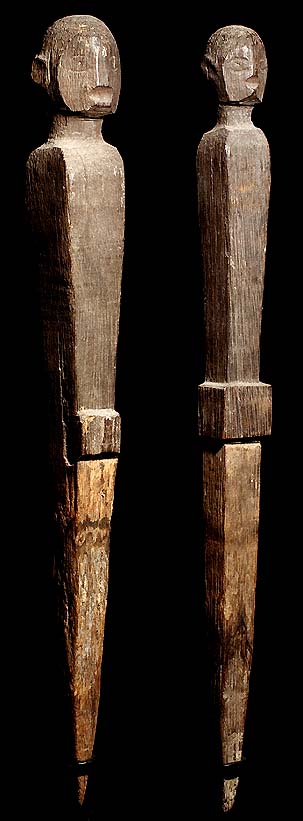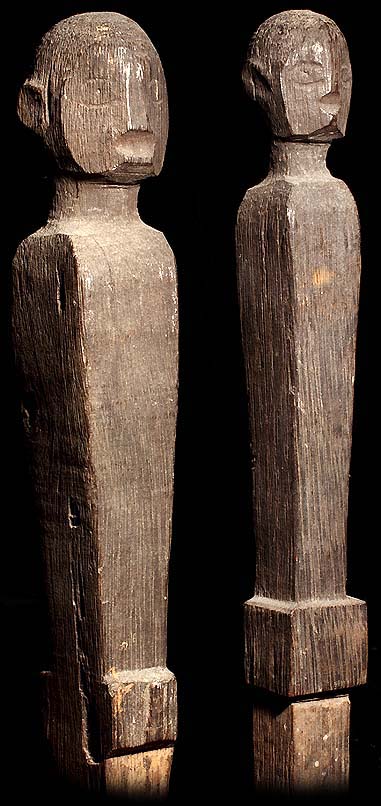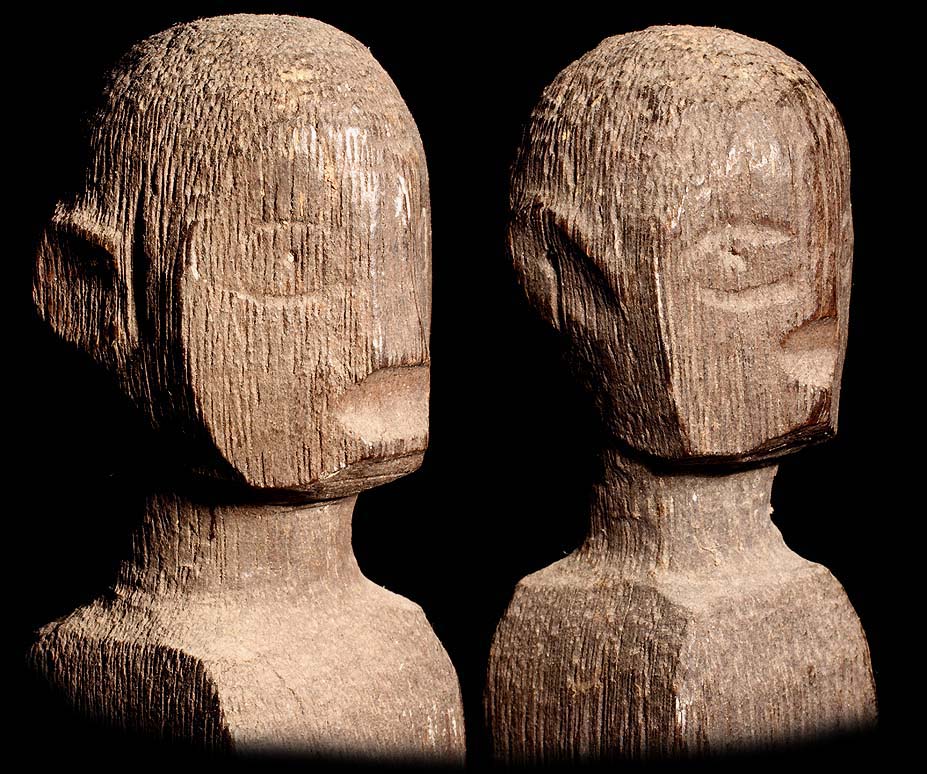



TUN TUN MATCHING PAIR #4 HAND CARVED HARD WOOD
FIGURES; WILD ANIMAL TRAP, AGOM RICE FIELD MARKERS
CIRCA; LATE 19TH CENTURY - EARLY 20TH CENTURY
USED ANTIQUE WITH CUSTOM MADE BLACK
METAL STANDS FOR BOTH
|
HAND CARVED WOODEN FIGURES LATE 19 - EARLY 20TH CENTURY |
    TUN TUN MATCHING PAIR #4 HAND CARVED HARD WOOD FIGURES; WILD ANIMAL TRAP, AGOM RICE FIELD MARKERS CIRCA; LATE 19TH CENTURY - EARLY 20TH CENTURY USED ANTIQUE WITH CUSTOM MADE BLACK METAL STANDS FOR BOTH |
|
These wooden sticks could have possibly been also used as a tun tun “pig traps” by the Iban Dayaks. In order to catch a pig, the Ibans would devise a spring trap using the tun tun to measure the height of the impaling spike. The top of this tun tun depicts a ancestor figure whose function to lure preys. Such traps were outlawed as being too dangerous by Raja Charles Brooke, the ruler of Sarawak in the 1880’s, and with the further adoption of firearms, became obsolete. The present piece is carved from hard wood and has a dark crusty patina from years of use. The life actions and decision-making processes of Iban Dayaks depend on divination, augury and omens. They have several methods to receive omens where omens can be obtained by deliberate seeking or chance encounters. The first method is via dream to receive charms, amulets (pengaroh, empelias, engkerabun) or medicine (obat) and curse (sumpah) from any gods, people of Panggau Libau and Gelong and any spirits or ghosts. The second method is via animal omens (burong laba) which have long-lasting effects such as from deer barking which is quite random in nature. The third method is via bird omens (burong bisa) which have short term effects that are commonly limited to a certain farming year or a certain activity at hands. The fourth method is via pig liver divination after festival celebration[38] At the end of critical festivals, the divination of the pig liver will be interpreted to forecast the outcome of the future or the luck of the individual who holds the festival.[39] The fifth but not the least method is via nampok or betapa (self-imposed isolation) to receive amulet, curse, medicine or healing. The Dayak people represent a group of Proto-Malayans inhabiting the inner part of Borneo (the largest Indonesian island). They are related to the Batak of northern Sumatra, Filipino Ifugao, and various tribes from Timor, Celebes, Sumatra and Moluccas. The Dayaks experienced many external influences, especially practice. Dayaks are highly conservative, and each village is organized in clans composed of various families who accept the authority of a single chief. Dayaks worship a superhuman power; "Semangat," that rules the lives of humans, animals and plants. This invisible life force is omnipresent: in all human body parts, shadows, names, the water in which a human or animal bathed, traces imprinted in mud... Semangat can enter any body. It's a "soul" that can be destroyed by more powerful entities. The Dayak beleive; each persons soul is inherited from a forebearer. Dayak wooden carvings host the souls of the dead. All Dayak souls submit to two divine powers: the sky; imaged as a hornbill bird, with land and water, symbolized by a snake. The Dayak practice "Kaharingan," which is a form of animism. The name was coined by Tjilik Riwut in 1944 during his tenure as a Dutch colonial Resident in Sampit, Dutch East Indies. In 1945, during the Japanese Occupation, the Japanese referred to Kaharingan as being the religion of the Dayak people. During the New Order in the Suharto regime in 1980, Kaharingan is registered as a form of Hinduism in Indonesia, while the Indonesian state only recognises 6 forms of religion; Islam, Protestantism, Roman Catholicism, Hinduism, Buddhism and Confucianism respectively. The integration of Kaharingan with Hinduism is not due to the similarities in the theological system, but due to the fact that Kaharingan is the oldest belief in Kalimantan, Borneo. Unlike the development in Indonesian Kalimantan, the Kaharingan is not recognised as a religion both in Malaysian Borneo and Brunei, thus the traditional Dayak belief system is known as a form of folk animism or pagan belief on the other side of the Indonesian border on Borneo Island. The practice of Kaharingan differs from group to group, but shamans, specialists in ecstatic flight to other spheres, are central to Dayak religion, and serve to bring together the various realms of Heaven (Upper-world) and earth, and even Under-world, for example healing the sick by retrieving their souls which are journeying on their way to the Upper-world land of the dead, accompanying and protecting the soul of a dead person on the way to their proper place in the Upper-world, presiding over annual renewal and agricultural regeneration festivals, etc. Death rituals are most elaborate when a noble (kamang) dies. On particular religious occasions, the spirit is believed to descend to partake in celebration, a mark of honour and respect to past ancestors and blessings for a prosperous future. The Dayak are feared for their ancient tradition of headhunting practices (the ritual is also known as Ngayau by the Dayaks). Among the Iban Dayaks, the origin of headhunting was believed to be meeting one of the mourning rules given by a spirit. Subsequently, the headhunting began to surface again in the mid-1940s, when the Allied Powers encouraged the practice against the Japanese Occupation of Borneo. It also slightly surged in the late 1960s when the Indonesian government encouraged Dayaks to purge Chinese from interior Kalimantan who were suspected of supporting communism in mainland China and also in the late 1990s when the Dayak started to attack Madurese emigrants in an explosion of ethnic violence. |
| |
David Howard, art, artist, photography,
photographic, photographs,
print, prints, director, producer, exhibitions, exhibits, exhibit,
painting, paint, studio, studios, etching, silkscreens, silkscreen,
contemporary art, Pop Art, artist's story, journal, video, videos,
documentary, documentaries, books, book, asian, asia, Filipino,
Philippines, Sacred Journey, author, The Last Filipino Head Hunters,
collections, collectables, collectable, archives, archive, art, fine,
contemporary, video, dvd, documentary, Keith Haring, Nam June Paik,
Christo, Lowell Nesbitt, Lawrence Ferlinghetti, Charles Arnoldi,
artists, studio visit, artist, program, sculpture, painting,
photography, prints, print,
photo, paintings, sculptures, keith haring, christo, david howard, nam
june
paik, artseen, videos tape, programs, documentaries, arts, world, san
francisco,
new york, los angeles
ANDY WARHOL, JOSEPH ALBERS, ELLSWORTH KELLY, CLAES
OLDENBURG,
ROBERT MOTHERWELL, FRANK STELLA, JAMES ROSENQUIST, ROBERT RAUSCHENBURG,
KEITH
HARING, CHRISTO, ROBERT INDIANA, ROY LICHTENSTEIN, ROBERT MAPPLETHORPE,
ALICE
NEAL, ARTISTS, ART, ARTIST, PAINTING, SCULPTURE, PHOTOGRAPHY, SITE
SPECIFIC,
NAM JUNE PAIK, KENNY SCHARF, LOWELL NESBITT, LAWRENCE FERLINGHETTI,
ARMAN
ARMAN, CHARLES ARNOLDI, CHRIS BURDEN, ART STUDIOS, VIRTUAL REALITY,
ABSTRACT
EXPRESSIONISM, PRINT MAKING, ETCHING, PAINTING, HOLOGRAPHY, AFRICAN
ART,
WOODCARVING, MURAL. MURALS, COMPUTER ART, FIGURATIVE EXPRESSIONISM,
IMPRESSIONISM,
MULTI-MEDIA, MULTI MEDIA